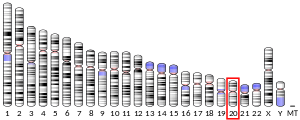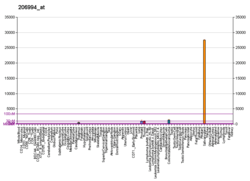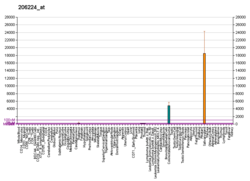CST1
Cystatin-SN is a protein that in humans is encoded by the CST1 gene.[3]
| CST1 | |||||||||||||||||||||||||
|---|---|---|---|---|---|---|---|---|---|---|---|---|---|---|---|---|---|---|---|---|---|---|---|---|---|
| Identifiers | |||||||||||||||||||||||||
| Aliases | CST1, cystatin SN | ||||||||||||||||||||||||
| External IDs | OMIM: 123855 HomoloGene: 88653 GeneCards: CST1 | ||||||||||||||||||||||||
| |||||||||||||||||||||||||
| |||||||||||||||||||||||||
| Orthologs | |||||||||||||||||||||||||
| Species | Human | Mouse | |||||||||||||||||||||||
| Entrez |
| ||||||||||||||||||||||||
| Ensembl |
| ||||||||||||||||||||||||
| UniProt |
| ||||||||||||||||||||||||
| RefSeq (mRNA) |
| ||||||||||||||||||||||||
| RefSeq (protein) |
| ||||||||||||||||||||||||
| Location (UCSC) | Chr 20: 23.75 – 23.75 Mb | n/a | |||||||||||||||||||||||
| PubMed search | [2] | n/a | |||||||||||||||||||||||
| Wikidata | |||||||||||||||||||||||||
| |||||||||||||||||||||||||
The cystatin superfamily encompasses proteins that contain multiple cystatin-like sequences. Some of the members are active cysteine protease inhibitors, while others have lost or perhaps never acquired this inhibitory activity. There are three inhibitory families in the superfamily, including the type 1 cystatins (stefins), type 2 cystatins and the kininogens. The type 2 cystatin proteins are a class of cysteine proteinase inhibitors found in a variety of human fluids and secretions, where they appear to provide protective functions. The cystatin locus on chromosome 20 contains the majority of the type 2 cystatin genes and pseudogenes. This gene is located in the cystatin locus and encodes a cysteine proteinase inhibitor found in saliva, tears, urine, and seminal fluid.[3]
References
- GRCh38: Ensembl release 89: ENSG00000170373 - Ensembl, May 2017
- "Human PubMed Reference:". National Center for Biotechnology Information, U.S. National Library of Medicine.
- "Entrez Gene: CST1 cystatin SN".
External links
- The MEROPS online database for peptidases and their inhibitors: I25.010
- Human CST1 genome location and CST1 gene details page in the UCSC Genome Browser.
Further reading
- Brown WM, Dziegielewska KM (1997). "Friends and relations of the cystatin superfamily--new members and their evolution". Protein Sci. 6 (1): 5–12. doi:10.1002/pro.5560060102. PMC 2143511. PMID 9007972.
- Takahashi M, Honda Y, Ogawa K, Barka T (1993). "Immunofluorescence localization of cystatins in human lacrimal gland and in the exorbital lacrimal gland of the rat". Acta Ophthalmologica. 70 (5): 625–31. doi:10.1111/j.1755-3768.1992.tb02143.x. PMID 1471486.
- Isemura S, Saitoh E, Sanada K, Minakata K (1992). "Identification of full-sized forms of salivary (S-type) cystatins (cystatin SN, cystatin SA, cystatin S, and two phosphorylated forms of cystatin S) in human whole saliva and determination of phosphorylation sites of cystatin S.". J. Biochem. 110 (4): 648–54. doi:10.1093/oxfordjournals.jbchem.a123634. PMID 1778989.
- Bobek LA, Aguirre A, Levine MJ (1991). "Human salivary cystatin S. Cloning, sequence analysis, hybridization in situ and immunocytochemistry". Biochem. J. 278 (3): 627–35. doi:10.1042/bj2780627. PMC 1151393. PMID 1898352.
- Al-Hashimi I, Dickinson DP, Levine MJ (1988). "Purification, molecular cloning, and sequencing of salivary cystatin SA-1". J. Biol. Chem. 263 (19): 9381–7. PMID 2837486.
- Saitoh E, Isemura S, Sanada K, et al. (1989). "Cystatin superfamily. Evidence that family II cystatin genes are evolutionarily related to family III cystatin genes". Biol. Chem. Hoppe-Seyler. 369 Suppl: 191–7. PMID 3202964.
- Saitoh E, Kim HS, Smithies O, Maeda N (1988). "Human cysteine-proteinase inhibitors: nucleotide sequence analysis of three members of the cystatin gene family". Gene. 61 (3): 329–38. doi:10.1016/0378-1119(87)90196-X. PMID 3446578.
- Isemura S, Saitoh E, Sanada K (1986). "Characterization of a new cysteine proteinase inhibitor of human saliva, cystatin SN, which is immunologically related to cystatin S.". FEBS Lett. 198 (1): 145–9. doi:10.1016/0014-5793(86)81201-7. PMID 3514272.
- Dickinson DP, Thiesse M, Dempsey LD, Millar SJ (1993). "Genomic cloning, physical mapping, and expression of human type 2 cystatin genes". Crit. Rev. Oral Biol. Med. 4 (3–4): 573–80. doi:10.1177/10454411930040034401. PMID 7690606.
- Dickinson DP, Zhao Y, Thiesse M, Siciliano MJ (1995). "Direct mapping of seven genes encoding human type 2 cystatins to a single site located at 20p11.2". Genomics. 24 (1): 172–5. doi:10.1006/geno.1994.1595. PMID 7896273.
- Thiesse M, Millar SJ, Dickinson DP (1994). "The human type 2 cystatin gene family consists of eight to nine members, with at least seven genes clustered at a single locus on human chromosome 20". DNA Cell Biol. 13 (2): 97–116. doi:10.1089/dna.1994.13.97. PMID 8179826.
- Henskens YM, van der Weijden FA, van den Keijbus PA, et al. (1996). "Effect of periodontal treatment on the protein composition of whole and parotid saliva". J. Periodontol. 67 (3): 205–12. doi:10.1902/jop.1996.67.3.205. PMID 8708950.
- Deloukas P, Matthews LH, Ashurst J, et al. (2002). "The DNA sequence and comparative analysis of human chromosome 20". Nature. 414 (6866): 865–71. doi:10.1038/414865a. PMID 11780052.
- Ghafouri B, Ståhlbom B, Tagesson C, Lindahl M (2002). "Newly identified proteins in human nasal lavage fluid from non-smokers and smokers using two-dimensional gel electrophoresis and peptide mass fingerprinting". Proteomics. 2 (1): 112–20. doi:10.1002/1615-9861(200201)2:1<112::AID-PROT112>3.0.CO;2-N. PMID 11788998.
- Dickinson DP, Thiesse M, Hicks MJ (2002). "Expression of type 2 cystatin genes CST1-CST5 in adult human tissues and the developing submandibular gland". DNA Cell Biol. 21 (1): 47–65. doi:10.1089/10445490252810311. PMID 11879580.
- Strausberg RL, Feingold EA, Grouse LH, et al. (2003). "Generation and initial analysis of more than 15,000 full-length human and mouse cDNA sequences". Proc. Natl. Acad. Sci. U.S.A. 99 (26): 16899–903. doi:10.1073/pnas.242603899. PMC 139241. PMID 12477932.
- Zhang Z, Henzel WJ (2005). "Signal peptide prediction based on analysis of experimentally verified cleavage sites". Protein Sci. 13 (10): 2819–24. doi:10.1110/ps.04682504. PMC 2286551. PMID 15340161.
- Gerhard DS, Wagner L, Feingold EA, et al. (2004). "The status, quality, and expansion of the NIH full-length cDNA project: the Mammalian Gene Collection (MGC)". Genome Res. 14 (10B): 2121–7. doi:10.1101/gr.2596504. PMC 528928. PMID 15489334.
- Ito T, Komiya-Ito A, Okuda K, et al. (2005). "Murine monoclonal antibody which can distinguish cystatins SA1 and SA2". Mol. Immunol. 42 (10): 1259–63. doi:10.1016/j.molimm.2004.11.021. PMC 7126565. PMID 15829315.



